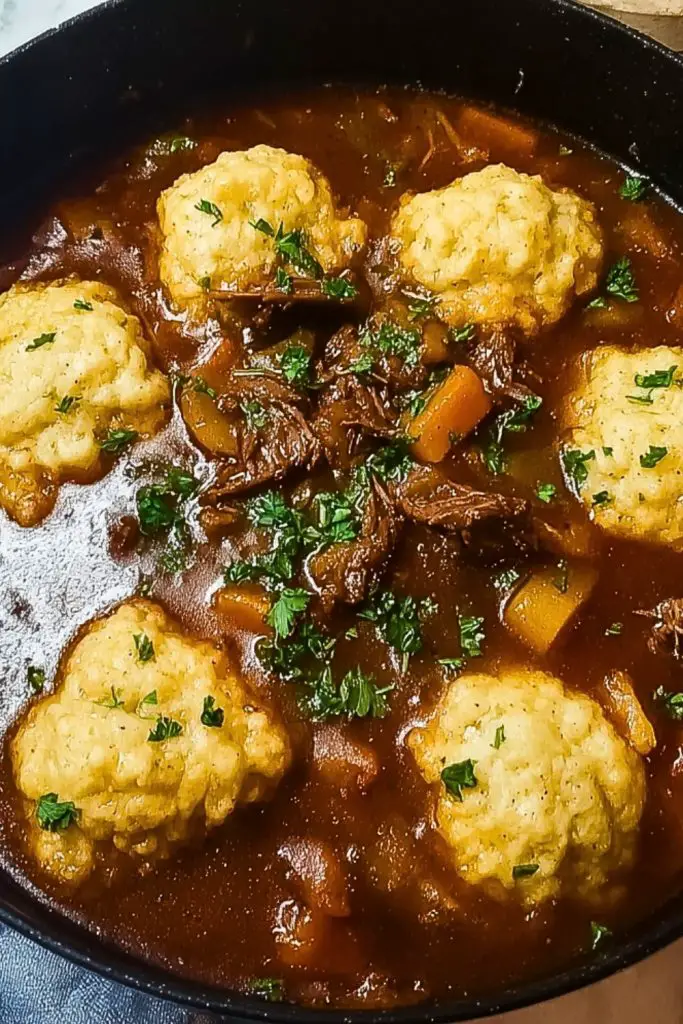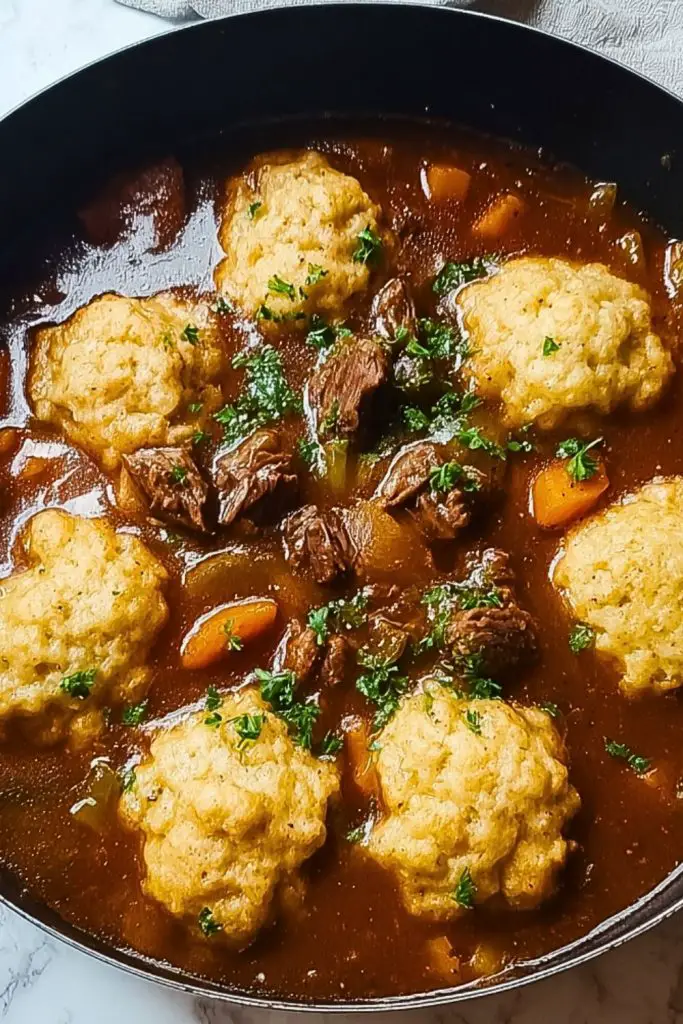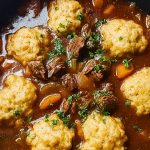Growing up, nothing signaled comfort more than the aroma of beef stew bubbling gently on the stove. It’s a dish that carries weight—not just in its rich, savory gravy and tender chunks of beef—but in the memories it brings with every spoonful. Add a few fluffy dumplings on top, and it turns into the kind of hearty, home-cooked meal that hugs you from the inside out. I’ve made this dish countless times, and each time it feels like hitting pause on the chaos of the day and settling into something deeply nourishing.

This version of beef stew and dumplings is my go-to when I need warmth and satisfaction in a bowl. It’s simple, deeply flavorful, and fills the kitchen with an irresistible scent that practically calls everyone to the table. The dumplings are soft yet sturdy enough to soak up the stew, and the beef melts in your mouth after a slow simmer. Whether you’re making it for Sunday dinner, a rainy night, or meal prepping for the week—this dish delivers every time.
Why You’ll Love This Beef Stew and Dumplings
- Ultimate comfort food: Rich gravy, tender beef, and pillowy dumplings make this dish a true classic.
- One-pot convenience: Everything cooks in one pot for easy cleanup and maximum flavor.
- Customizable: Add your favorite root vegetables or fresh herbs to make it your own.
- Make-ahead friendly: Tastes even better the next day!
- Perfect for cold weather: Warms you up from the inside out.
What Cut of Beef is Best for Beef Stew and Dumplings?
When making beef stew, the best results come from tougher cuts that become tender after a long, slow cook. I always reach for chuck roast—it has just the right amount of fat and connective tissue to break down and create that melt-in-your-mouth texture. Stewing beef (already cubed) is a quick and convenient option too, though I find the quality can vary depending on where you buy it.
If you’re feeling adventurous or want to go extra rustic, beef shin (or shank) adds deep flavor thanks to the marrow. Just be sure to give it plenty of time to cook low and slow. The beauty of stew is in the transformation—tough cuts become succulent, flavorful bites when treated with patience.
Options for Substitutions
Whether you’re missing an ingredient or want to switch things up, here are some easy substitutions that work wonderfully in this recipe:
- Beef: Swap with lamb shoulder for a richer, slightly gamey flavor, or use mushrooms and lentils for a vegetarian version.
- Dumplings: No self-raising flour? Add 2 teaspoons of baking powder per cup of all-purpose flour. Or try potato gnocchi as a fun twist.
- Vegetables: Root veggies like parsnips, sweet potatoes, or turnips work well in place of carrots or potatoes.
- Stock: Use chicken or vegetable stock if you’re out of beef stock. Just adjust the seasoning to balance the richness.
- Herbs: Thyme is classic, but rosemary, bay leaves, or even a dash of dried Italian seasoning can bring great flavor.
These tweaks can help make the dish your own without sacrificing that rich, stew-and-dumpling comfort.
Ingredients for This Beef Stew and Dumplings
- Beef Chuck Roast
This is the heart of the stew—marbled with fat and connective tissue, it becomes tender and flavorful after a slow simmer. - Onions
They form the aromatic base and add natural sweetness as they cook down. - Carrots
They bring color and a subtle earthy sweetness that balances the savory stew. - Celery
Adds depth and a hint of bitterness to round out the flavor. - Garlic
A few cloves bring a rich, savory punch that enhances the entire dish. - Tomato Paste
It adds umami and gives the gravy that deep, reddish color and complexity. - Beef Stock
The liquid gold that ties everything together—rich and full-bodied, it’s essential for flavor and moisture. - Worcestershire Sauce
Just a splash gives the stew a tangy, savory edge that wakes everything up. - Flour
Used to coat the beef for browning, which also helps thicken the stew as it cooks. - Salt & Black Pepper
The basics, but essential for drawing out every layer of flavor. - Fresh Thyme
An aromatic herb that brings freshness and a bit of rustic charm. - Bay Leaves
They infuse the stew with subtle, warm spice over time.
For the Dumplings:
- Self-Raising Flour
Gives the dumplings their rise and fluffiness. - Butter
Adds richness and helps create that tender crumb. - Milk
Brings the dough together while keeping the dumplings light and soft. - Salt
Just a pinch to season the dough without overpowering it. - Fresh Parsley (optional)
Finely chopped, it adds a fresh pop of color and flavor to the dumplings.

Step 1: Sear the Beef
Start by cutting the beef chuck into bite-sized chunks and season with salt and pepper. Toss the pieces in a bit of flour to coat. Heat some oil in a large Dutch oven or heavy-bottomed pot over medium-high heat. Sear the beef in batches until browned on all sides—don’t overcrowd the pan. This step builds the foundation of flavor for your stew.
Step 2: Build the Flavor Base
Once all the beef is browned and set aside, lower the heat and add diced onions, carrots, and celery to the same pot. Cook for about 5–7 minutes, stirring often, until the vegetables begin to soften. Add the garlic and tomato paste, stirring for another minute until fragrant and slightly caramelized.
Step 3: Deglaze and Simmer
Pour in a splash of Worcestershire sauce and scrape up all the golden bits stuck to the bottom of the pot. Return the beef to the pot and pour in enough beef stock to just cover everything. Toss in the bay leaves and a few sprigs of thyme. Bring to a gentle boil, then reduce the heat to low, cover, and let it simmer for 1.5 to 2 hours until the beef is fork-tender.
Step 4: Make the Dumpling Dough
While the stew is simmering, prepare your dumplings. In a bowl, combine self-raising flour and a pinch of salt. Rub in cold butter with your fingertips until the mix looks like breadcrumbs. Stir in milk gradually until a soft, sticky dough forms. Add chopped parsley if using. Don’t overwork it—gentle hands make fluffy dumplings.
Step 5: Add the Dumplings
Once the beef is tender and the stew has thickened slightly, remove the bay leaves and thyme stems. Scoop small spoonfuls of the dumpling dough and gently drop them on top of the simmering stew. Cover the pot with a lid and cook on low heat for 15–20 minutes—resist the urge to peek, the steam is what cooks the dumplings.
Step 6: Final Touches
When the dumplings are puffed up and cooked through, uncover the pot and let it simmer for another 5 minutes to firm them up a bit. Sprinkle fresh herbs over the top, and taste the stew one last time to adjust salt or pepper if needed. Serve hot and enjoy the cozy satisfaction.
How Long to Cook Beef Stew and Dumplings
The full process takes about 2 to 2.5 hours from start to finish, but most of that time is hands-off simmering. Here’s a quick breakdown:
- Searing the beef and prepping veggies: 20–25 minutes
- Simmering the stew: 1.5 to 2 hours for tender, flavorful beef
- Cooking the dumplings: 15–20 minutes covered, plus 5 minutes uncovered to firm them up
It’s slow food at its best—low and slow cooking transforms basic ingredients into something extraordinary.
Tips for Perfect Beef Stew and Dumplings
- Brown the beef properly: Get that deep, golden crust on the meat—it adds serious flavor. Don’t rush this step.
- Use a heavy pot: A Dutch oven or cast-iron pot retains heat and distributes it evenly, perfect for long simmers.
- Low and slow wins the race: Don’t boil the stew—keep it at a gentle simmer to avoid tough meat.
- Don’t peek at the dumplings: Lifting the lid too early can prevent them from rising properly. Let steam do its thing.
- Add vegetables later if needed: If you’re using softer veggies like peas, toss them in during the last 15 minutes so they don’t turn mushy.
- Taste and adjust: Before serving, give the stew a final taste to check for seasoning—you might need an extra pinch of salt or a dash more Worcestershire.
With these simple tips, you’ll turn out a bowl of beef stew and dumplings that’s rich, comforting, and absolutely crave-worthy.
Watch Out for These Mistakes While Cooking
Even a classic like beef stew and dumplings can go sideways if you miss a few details. Here’s what to watch for:
- Skipping the browning step: This is where so much flavor develops. Rushing this part can leave your stew tasting flat.
- Boiling instead of simmering: High heat makes the beef tough and the sauce thin. Keep it at a low, gentle simmer.
- Overcrowding the pan when searing: If you throw in all the beef at once, it’ll steam instead of brown. Sear in batches.
- Overmixing the dumpling dough: Mix until just combined—overworking it leads to dense, chewy dumplings.
- Peeking too soon: Opening the lid while dumplings cook lets steam escape and can ruin their texture. Trust the process.
- Not skimming fat: If your stew has a greasy surface, a quick skim with a spoon or paper towel makes a world of difference.
What to Serve With Beef Stew and Dumplings?
Steamed Green Beans
A light, crunchy veggie to balance the richness of the stew. Add a sprinkle of sea salt or a squeeze of lemon.
Simple Green Salad
Mixed greens tossed with a tangy vinaigrette help refresh your palate between hearty bites.
Crusty Bread
Even with dumplings, a slice of rustic sourdough or baguette is perfect for wiping the bowl clean.
A Glass of Red Wine
A bold red like Cabernet Sauvignon or Malbec pairs beautifully with the depth of the stew.
Herb Butter Peas
Sweet peas sautéed in a little butter and chopped herbs make a fast and flavorful side.
Roasted Garlic Mashed Potatoes
If you’re feeling indulgent, a scoop of garlicky mash under the stew is ridiculously comforting.
A Sharp Cheddar Cheese Plate
If serving for guests, a little cheese on the side can elevate things into a casual-yet-special dinner.
Storage Instructions
Leftovers of beef stew and dumplings store beautifully, and in many cases, they taste even better the next day.
- Refrigerator: Transfer the cooled stew and dumplings into an airtight container and refrigerate for up to 4 days. Keep dumplings on top to prevent them from getting too soggy.
- Freezer: You can freeze the stew (without dumplings) for up to 3 months. Dumplings don’t hold up well in the freezer—they become mushy when thawed—so it’s best to make those fresh.
- Reheating: Warm gently on the stovetop over low heat, stirring occasionally. If reheating dumplings, add a splash of broth and cover the pot to steam them back to life.
Estimated Nutrition (Per Serving — Based on 6 Servings)
- Calories: 510 kcal
- Protein: 36g
- Carbohydrates: 32g
- Fat: 26g
- Saturated Fat: 11g
- Unsaturated Fat: 13g
- Trans Fat: 0.5g
- Cholesterol: 105mg
- Fiber: 4g
- Sugar: 6g
- Sodium: 880mg
- Serving Size: About 1.5 cups of stew with 2 dumplings
Please note: Nutrition may vary based on specific ingredients and portion sizes used.
Frequently Asked Questions
What if I don’t have self-raising flour for the dumplings?
No worries—just use regular all-purpose flour and add 2 teaspoons of baking powder per cup to make your own self-raising flour substitute.
Can I make this stew in a slow cooker?
Yes! After searing the beef and sautéing the vegetables, transfer everything to a slow cooker and cook on low for 7–8 hours or high for 4–5 hours. Add dumplings in the last 30–40 minutes.
Can I make the stew ahead of time?
Absolutely. The stew can be made up to 3 days ahead and stored in the fridge. Just reheat gently and make the dumplings fresh when you’re ready to serve.
How do I know when the dumplings are done?
They should be puffed up and firm to the touch, not doughy. You can test one by cutting it in half—if it’s cooked through, it’s ready.
Can I add wine to the stew?
Definitely. A splash of red wine (about ½ cup) adds amazing depth. Just add it after sautéing the vegetables and let it reduce before adding stock.
What veggies can I add to this stew?
Root veggies like parsnips, turnips, and sweet potatoes work great. Toward the end of cooking, toss in peas or green beans for a pop of color.
Is this dish freezer-friendly?
The stew freezes well, but dumplings do not. For freezing, leave the dumplings out and make a fresh batch when you reheat the stew.
Can I make this gluten-free?
Yes! Use gluten-free flour blends for both the stew thickener and dumplings. Just make sure your baking powder and stock are also gluten-free.
Conclusion
Beef stew and dumplings is more than just a meal—it’s pure, slow-cooked comfort in a bowl. With deeply savory broth, tender chunks of beef, and soft dumplings that soak up every bit of flavor, it’s the kind of dish that makes you slow down and savor. Whether you’re feeding your family, impressing dinner guests, or just craving something cozy, this recipe always hits the mark. Once you try it, you’ll understand why this is the kind of meal you return to again and again.

Delicious Beef Stew and Dumplings
- Total Time: 2 hours 25 minutes
- Yield: 6 servings
Description
Sink into comfort with this hearty Beef Stew and Dumplings, a one-pot wonder packed with melt-in-your-mouth beef, savory vegetables, and fluffy dumplings that soak up every drop of rich, flavorful gravy. Perfect for cozy nights, easy dinner plans, or comforting meal prep ideas, this dish transforms simple ingredients into a slow-cooked classic that never disappoints. Whether you’re looking for quick comfort food, family dinner ideas, or easy recipes for colder days, this beef stew checks all the boxes.
Ingredients
700g beef chuck roast, cut into chunks
2 tablespoons plain flour
1 tablespoon vegetable oil
1 large onion, diced
2 carrots, peeled and sliced
2 celery sticks, chopped
3 garlic cloves, minced
1 tablespoon tomato paste
750ml beef stock
1 tablespoon Worcestershire sauce
2 bay leaves
3 sprigs fresh thyme
Salt, to taste
Black pepper, to taste
200g self-raising flour
100g cold butter, cubed
100ml milk
1 tablespoon chopped fresh parsley (optional)
Pinch of salt
Instructions
1. Season beef chunks with salt and pepper, then toss in flour until lightly coated.
2. Heat oil in a heavy pot over medium-high heat and brown beef in batches. Set aside.
3. Lower the heat and add onions, carrots, and celery. Sauté for 5–7 minutes until softened.
4. Stir in garlic and tomato paste; cook for 1 minute until fragrant.
5. Deglaze with Worcestershire sauce, scraping up browned bits.
6. Return beef to the pot, pour in stock to cover, and add bay leaves and thyme.
7. Bring to a boil, then reduce heat to low, cover, and simmer for 1.5–2 hours.
8. To make dumplings, rub butter into flour with a pinch of salt until breadcrumb-like.
9. Stir in milk gradually to form a soft dough. Fold in parsley if using.
10. Drop spoonfuls of dough on top of simmering stew.
11. Cover and cook for 15–20 minutes—don’t lift the lid.
12. Remove lid and cook 5 more minutes to firm up dumplings.
13. Discard bay leaves and thyme. Taste and adjust seasoning.
14. Serve hot, garnished with extra parsley if desired.
Notes
Don’t skip searing the beef—it builds the base flavor of the whole stew.
Make dumplings fresh; they don’t freeze well and lose their fluffy texture when reheated.
For thicker gravy, remove the lid in the final 15 minutes of simmering before adding dumplings.
- Prep Time: 25 minutes
- Cook Time: 2 hours
- Category: Main Course
- Method: Simmering
- Cuisine: British
Nutrition
- Serving Size: 1.5 cups stew with 2 dumplings
- Calories: 510
- Sugar: 6g
- Sodium: 880mg
- Fat: 26g
- Saturated Fat: 11g
- Unsaturated Fat: 13g
- Trans Fat: 0.5g
- Carbohydrates: 32g
- Fiber: 4g
- Protein: 36g
- Cholesterol: 105mg
Keywords: beef stew and dumplings, easy dinner, comfort food, family meal, stew with dumplings

